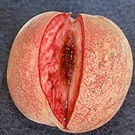Indian Blood Peach
Plant Profile:
Eons ago, when I was just a wee young dragonling there were peaches that were so sweet and tender they nearly melted in my maw! As the years passed, these luscious gems became hard and insipid. Why? Was my memory of times hazed by the fogs of time or was there really a shift in quality?
Using draconic tools of books and Google and did I mention books? A discovery was made! Most peaches (or fruits of any sort for that matter) available at the average marketplace are from plants specifically grown to produce not just bumper crops for more gold (oh, sorry, that’s right people call it cash now right?) but also for thick skins and harder flesh to make for easier transport.
Though my reptilian mind can fathom why the above qualities would be a boon for growers – it’s certainly not conductive to delightful devouring! Peaches ought to be soft and succulent and juicy and… ahem…I digress.
Do expect these enticing, red fleshed Blood Peaches from Willis Orchard to be tangy sweet in comparison to your mundane variety found at grocery centers and should be picked when ripe. Glut on them while they’re fresh and before they start to degrade – dry, can, bake or freeze them. Or for the more ambitious folks out there they make great chutney!
Plus it’s a clingstone, which are getting harder to find so – score!
There’s a similar variety out there confusingly named the Indian Blood Peach Freestone or Blood Free. This is an entirely different peach and, from what I’ve found, isn’t related to the heirloom Indian Blood Peach cling.
Height: Standard
Zone: 4-8
Blooms: Mid-spring, pink
Chill Hours: 900
Space: 20-25’ apart
Uses: Eat fresh, can, freeze or bake. It can be used in any recipe that calls for peaches.
Harvest: Big, red cling peaches in August – September
* Photo by Willis Orchards, used with permission

